Omkara Upasana
In the13th Class of Taitreya Upanishad, Swamiji discusses Omkara Upasana. This upasana is presented in the form of a chart. Please click on the link for a chart form of this Upasana.
In the13th Class of Taitreya Upanishad, Swamiji discusses Omkara Upasana. This upasana is presented in the form of a chart. Please click on the link for a chart form of this Upasana.
This is a PDF document of Ramana Maharishi’s Saddarshanam. Please click on the link to download:
Questions:
The first two questions are answered in verse 2. To answer the third question, a story is told, personifying all tatvas or pricinciples.
Verse 3
One day prana called all 19 principles. Don’t get deluded regarding the glory of who sustains the body, because I the prana alone divide into five, prana (respiratory), apana (excretory) , vyana (circulatory), samana (digestive) and udhana (reversing), and sustain the whole individual. However, the 19 principles did not believe because of their vanity.
Verse 4
To prove the point, Prana pretended to go out. As prana started to leave other principles also followed prana because their very existences dependent on Prana. And prana came back and all the 19 principles came back. This is the direct proof that all principles are dependent on prana sakthi. The 19 principles were pleased as the Prana did not go away permanently. Swamiji gave the example of Queen Bee, where the entire beehive follows the Queen Bee without any question. Similarly, the 19 principles followed Prana without any question. With this the 19 principles understood the glory of prana.
The rest of the section is prana sthuthi by the 19 principles.
Verse 5
In this verse, prana is glorified at micro and macro levels.
Glorificattion at individual level – prana sakthi gives power to eyes, ears etc. At the cosmic or macro level, hiranyagarba alone appears as burning power of agni, appears as light energy in sun. Similarly, Indira, Vayu, Earth, Moon are all powered by Prana sakthi. Prana sakthi broken down is all Murtha (formed) and amurtha (formless) vasthu (objects).
Verse 6
All the vedas, yagyas, warriors, brahmanas, the whole creation is based on prana. Without prana nothing can survive. In a wheel, the outer rim appears to be supported by spokes, but in reality, the spokes are supported by the hub. The whole wheel supported by the hub. Similarly all principles are supported by prana sakthi. In this example, each spoke can be taken as different principle; the wheel as the whole creation and prana as the hub.
Namaste:
This are my notes from New Year talk given by Swamiji on January 1, 2016:
You can listen to this talk here.
The topic of this talk was six principles of tolerance.
Swamiji started the talk by pointing out that the topic of tolerance is in the news now a days and that both Tatva Bodha and Bagawat Geeta point out the need for tolerance. Tatva Bodha says one need thithiksha (mental shock absorbers) to withstand the ups and downs of life. Lord Krishna says in Chapter 2 of Bagawat Geeta that one need shama to withstand the up and downs of life.
Six principles of tolerance:
Swamiji concluded that if we follow these six principles, then we will be able to handle and move on after any difficult experience.
Important points made by first section:
Shristi is the first point: Life and death are not opposite but complementary pair of nature; similar is growth and decay. We must accept the pair. Shrusti as a form of mithunam. Five shristies mentioned in the first section are:
Second point is Chukla Krishna Gathi topic was discussed after shristi as a diversion.
Third point is discipline of brahmanacharyim
Second Section
Para vidhya and apara vidhya are from Mundaka Upanishad. Apra Vidhya or preparatory knowledge consists of karma and upasana. First chapter of Mundaka Upanishad elaborately discussed karma (e.g. agni hothram) but upasana (mental activity for saguana brahman) was not discussed in detail. Physical activities like pooja are not upasana. Vedanta is mental activity for nirguna brahman.
Second section: Hiranyagarbha (prana) sthuthi. Prior to upsana, the upsana deity should be glorified.
Hiranyagarbha is consciousness with the total (all) subtle body. This total subtle body is available as individual subtle body for everyone. Of the 17 organs of sukshma sareeram, prana is the most important one. Prana keeps body alive. Also during sleep, all sense organs come to a standstill except prana.
Third Section: Hiranyagarbha (prana) upasana is samashti prana, because Hiranyagarba blesses everyone as prana.
V1
Question: What are the devadas that sustain the people (sareeram)? Devadas are various factors or principles behind every inert object. This consciousness principle is called Devada. Sun is not just an object, but when we consider that sun is pervaded by Eeswara, we call it Surya Deva. Each principle is called deva for this reason. So the first question is how many devas are sustaining the sareeram. Second question what principles (devas) are publicizing their own glories. Third Question is among these devas who is the greatest devada?
V2
First principle sustaining the sareeram is 19 devas. because it provides a place to live. The 24 devas are:
All 19 devas except prana claim they are the most important.
The rest of the section is answer to third question.
Rayee and prana are conceptual pairs. Prajapathi alone comes as conceptual pairs of rayee and prana.
Samvatsara, consisting of dakshinayana and utharayana (kala) is prajapathhi.
Krishna kathi and chukla kathi are subtle or divine road through which a jiva travels to other logas. Krishna kathi leads to Chandra loga and chukla kathi leads surya loga or brahma loga. Those people who perform rituals go to Chandra kathi and those who perform upsaha will go to surya loga. Gyani does not go through either of the logas because he gets moksha here and now. Dhashinayanam represents Krishna kathi and represented by various dhashinayana devadas; utharayanam represents chukla kathi presided by utharayana devadas.
Krishna gathi, dakshinayanam and Chandra loga are all rayee; Utharayanam, surya loka and chukla gathi are all prana.
Verse 10
Chukla kathi is the path; the travelers are upasaha or karma upasa samuchayaha. Brahama loga is immortality because brahmaloga gives moksha which is immortality. Upasaha seek surya loga, upasana by following discipline (control of sense organs and faith in scriptures). For all pranas, this surya loga is the goal. This loga is mean for upsahas only and not available to others.
Verse 11
Adhithya praised as a destination of chukla gathi: Surya is endowed with five feet (five seasons are taken as feet of Surya loga because Surya moves creating the five seasons) so surya is called panca patham. Six seasons in scriptures are spring, summer, rainy, autum, pre-winter and winter. In this verse pre-winter and winter are combined as one season. There are 12 different appearance to sun one for each month. Due to utharayanam and dakshinayanam, sun is the father of all beings.
I had difficulty in comprehending and digesting this class and summarized as best as I can. I greatly appreciate any corrections, additions and comments to my summary.
In the last class, Swamiji stated that Rayee is a non translatable word. For my own sake of understanding this Upsanishad, I equate Rayee to matter and Prana to energy with the full recognition that Rayee and Prana are spiritual and philosophical terms and they encompass much more than the modern scientific terms of energy and matter – for example, prana and rayee include formless thoughts and action. While equating Rayee and Prana to matter and energy is not recommended, I found it easier to understand these classes.
First creation is in form pairs or mithuna shristy or the creation of rayee and prana. Rayee and prana are two principles pairs of opposite mutually complementary; both of them together make a whole. This division between rayee and prana is superficial; rayee is prajabathi or cause or karanam; prajapathi alone becomes rayee and prana. Superfically we call amoortha as prana and moortha as rayee. But since both rayee and prana came from prajapathi, everything can be called rayee and similarly everything can be called prana. For example, ice is also be called water, stream is also called water. The ice/stream division is superficial and both are water. Similarly the division between rayee and prana is also superficial as both are prajapathi.
V6
After mithuna shrishty, Swamiji discussed loga shristy or sun (prana) and moon (rayee). By spreading the rays from the east, the sun is embracing all jivas and becoming one with all jivas. The sun alone is giving life and energy to all beings and therefore the existence of beings is due to sun’s energy and therefore there is no jivas other than sun. Physical energy, prana energy and intellectual energy all are given only by surya prakasha.
V7
The sun is known as vaisvanara, the macro gross body in waking stage. The surya alone is in the form all human beings.
Surya is known as visvaroopa, prana (life of everyone), Agni (fire). When the fire principle is up above, we call it surya and when it is down on the earth, we call it Agni. Without sun, there will be no life. This principle is also supported by the following mantra in Rig Veda.
V8 (Mantra from Rig Veda)
Sun is omniscient because it illuminates everything. Rishis knew sun to be all of the following:
The conclusions of these three slokas is that prana or sun is everything.
V9
After loga shrishity, comes the kala shrishti, which is recognized by the movement of sun and moon. Surya prakasam determines the day; Chandra’s, on the other hand, determines thithi. The whole year is prajapathi because sun and moon are manifestation of prajapathi. So kalam is a manifestation of prajapathi. A year has two ayanam (solstice). Dhakshinayanam (rayee) and utharayanam (prana).
On November 8, 2015, the Vedantic Study Group of HTGC started to listen to Prasna Upanishad by Swami Paramarthananda.
Swamiji started the class with the meaning of Vedanta:
Then Swamiji discussed different meanings of the word Upanishad :
Prasna upanishad belongs to Atharvana Veda and one of the upanishads commented by Sankarachariyar.
This upanishad is a commentary on Mundaka Upanishad. Apara Vidya and apara vidya is mentioned in Mundaka Upanishads will be elaborated in Prasna upanishad. Condensed version in Mundaka Upanisahds are manthro upanishad and elaborated versions in Prasna upanisahds are brahmano Upanishads. Brahmno portions in Mundaka Upanishads are elaborated in Prasna upanishads. Chapters elobarated in Prasna Upanishad are:
Prasnaha means question; each chapter begins with question and each chapter is answer to that question. Each question is asked by six different students.
Shanthi Pada: My sthula, shuksma sareeram should function in a fitting manner so that I can absorb the teaching. This shanthi pada is same as the one in Mundaka Upanishads and as a result, Swamiji did not elaborate the meaning.
Verse 1
The first two mantras are introductions by way of bringing the teacher and student together. In this mantra six students are introduced. Each student has two names. The first name is an original name and second is based on parampara. They are: Sukesa Bharadvaja, Satyakama Sibi, Surya Garga, Kausalya Asvalayana, Bhargava Vidharbha, and Kabandhin Katya. The names tell us of their great parentage. It informs us that they had good Samskara. Samskaras are there to create Shraddha in Vedas. All of them are well qualified. They are all Gyani’s. They have now come for higher knowledge. This mantra also teaches us:
An Excellent summary by Ram Ramaswamy.
Moving on to Part 2, Cantos 3, Mantra Swamiji says this third and final section of Katho Upanishad deals with Atmavidya, Brahmavidya Sadhanani and preparation for Brahmavidya.
Mantra #1: This is an important mantra. It deals with nature of Brahman. Yama now compares Creation to the Ashwatha Vriksha or Pipal Tree. Shankara in his commentary says there are many things common between the two. Describing them, he says:
Elaborating further, even the biggest dream is in the Waker. Nachiketas asks Yama why are you talking about Brahman when I wanted to know about Atman. Yama tells him: You are everything. You are Brahman.
Mantra # 2:
Providing further clarification Swamiji says, Brahman is the intelligent cause of life. Just as dream world emerges from the Waker, everything emerges and functions in presence of Brahman. He is the creator and maintainer of everything.
Swamiji says Brahman also polices this Creation ensuring the Universe functions in an orderly manner. This policing intelligence is also called Ishwara. Those who know this achieve immortality. Swamiji adds every suffering we undergo is a punishment for some violation. Every violation of Dharma results in sorrow.
Suggested Practice:
Mr. and Mrs. Narayan recently visited Swamiji during their trip to Chennai. They informed him of our group’s activities. Swamiji was very happy. He suggested that the Vedanta group read and practice the teachings of Chapter 17 of the Geeta. This chapter deals with the Gunas or our qualities.
Here are the instructions to build a five step golu padi that is five feet wide. You need 100 feet of 3/4″ pvc pipe, 16 Tees and 16 side elbows. For assembly, you need a hammer or mallet, PVC pipe cutter, tape measure and level finder.
Cut the 120 foot pipe into the following pieces:
These cuttings allow for a gain of 1.5″ for each fixture used. This 1.5″ can be used to compensate for minor cutting errors. Do not cut them all at the beginning; Cut the pieces as you go along when you need them. These measurements will result in the support for steps at 4’6″ – allowing for 6″ over hang on either side and a 6″ overhang in front for each step.
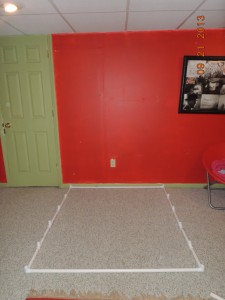
First Step is to build the base. For the four corners you need the side elbows; On the front and back use two 51″ pipes; on each side use five 10″ pipes; between the 10 ” pipes, install tees (8 in total). Snugly fit the pipes together, with the open outlet of the tee upwards. Use the hammer to lightly tap the pipes and fitting together, but do not force them all the way in. You will need some space to adjust for any variations in cutting.
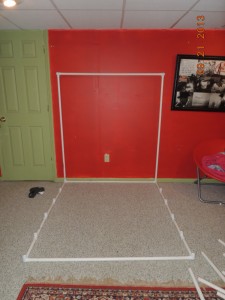
Install the first step by using two 57″ pipes on to the two side elbows on the back of the base. Install two side elbows on the top of the two pipes and connect them with one 51″ pipe. Tap all pipes into place, but do not over tighten them yet.
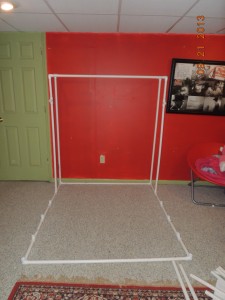
Insert 9″ pipe on top each of the tees on the 45″ pipe. Insert side elbows on top of each of thees 9″ pipes; complete the first step frame with two 9″ pipe and one 51″ pipe.
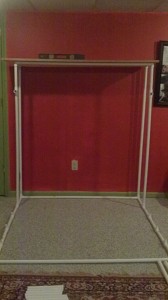
Ensure the first step is in level on both directions. Tap the pipes slightly to get them in level – go gently as you will need the play room for final fitting.
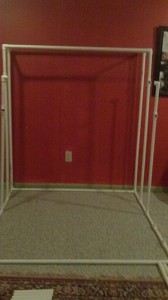
Install two 35″ pipes onto the next two tees. Insert two tees on top and attach 9″ pipes on top of each tee.
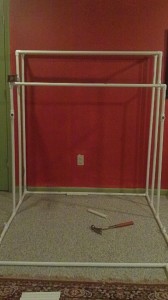
Complete the second step with one 51″ pipe and two 10″ pipe. Level in both directions and tap in the pipes if necessary